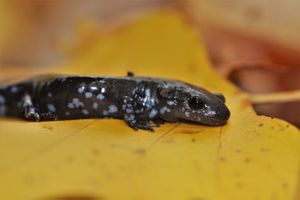Blue-spotted salamander
Physical Description

The Blue-spotted Salamander is black with blue spots and specks all over the body, sides, arms, and tail. They have 12-14 costal grooves. Adults grow to be 3-5 inches ( 7.6-14 cm), females are slightly larger than males.
Habitat
Their distribution range spreads from the north of the New England area to as far west as Wisconsin and Minnesota. These salamanders are cold tolerant and live in both deciduous and coniferous forests with moist woodlands. The presence of Vernal Pools that retain water into the mid-summer is essential for their habitat. One would most likely find them underneath the leaf litter and logs. During the warmer months they may even move about in the open during rain showers.
Similar to many amphibian species, their habitat is being threatened by human development. Commercial, residential, and industrial construction all have negative impacts upon their populations and habitat. Blue-spotted Salamanders are listed as "Least Concern" by the IUCN Red List.
Ecology
Their diet consists of mostly small invertebrates such as snails, earthworms, centipedes, and spiders. When the salamanders are in the breeding pools they can also eat aquatic invertebrates like water fleas and copepods. They prefer to spend most of their time hidden in darkness under logs and fallen leaves. When darkness or rain comes they will venture out in the open. If danger presents itself these salamanders are capable of producing noxious secretions. These are a form of defensive measures.
Reproduction
Breeding season begins in late March to early April with the salamanders migrating to the vernal pools. Courtship ensues with the male using his snout to nuzzle and nudge the female. He then mounts the female, using his front legs to hold her body, and then rubs his chin on her head. This can continue for several hours with the pair periodically coming to the surface for air and then returning underwater.
After the courtship the male releases the female and deposits a spermatophore in front of her. If all goes well the female will move over the spermatophore and take it into her cloaca. Males are able to produce 10-40 spermatophores during one breeding season, although many of these are not used by females. Females lay 1-12 eggs per clutch, which are laid in a gelatinous mass usually on sticks, leaves, or rocks underneath the water. Eggs will hatch in three to five weeks. The larvae go through their metaphorphsis in the late summer and will continue their life cycle on land.
References
[1] Harding, J. & Mifsud, D. "Amphibians & Reptiles of the Great Lakes Region". University of Michigan Press, 2017. pg 58-62
[2] "Ambystoma laterale" IUCN Red List of Threatended Species. 2004.
[3] Blue-spotted salamander photographed at Letchworth Woods, University at Buffalo on 25th October 2020 by Nikolai Harper